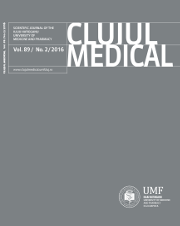Novel non invasive diagnostic strategies in bladder cancer
DOI:
https://doi.org/10.15386/cjmed-534Keywords:
bladder cancer, molecular diagnostic biomarkers, miRNA, genetic polymorphism, early diagnosisAbstract
Bladder cancer is one of the most commonly diagnosed malignancies worldwide, derived from the urothelium of the urinary bladder and defined by long asymptomatic and atypical clinical picture. Its complex etiopathogenesis is dependent on numerous risk factors that can be divided into three distinct categories: genetic and molecular abnormalities, chemical or environmental exposure and previous genitourinary disorders and family history of different malignancies. Various genetic polymorphisms and microRNA might represent useful diagnostic or prognostic biomarkers. Genetic and molecular abnormalities - risk factors are represented by miRNA or genetic polymorphisms proved to be part of bladder carcinogenesis such as: genetic mutations of oncogenes TP53, Ras, Rb1 or p21 oncoproteins, cyclin D or genetic polymorhisms of XPD,ERCC1, CYP1B1, NQO1C609T, MDM2SNP309, CHEK2, ERCC6, NRF2, NQO1Pro187Ser polymorphism and microRNA (miR-143, -145, -222, -210, -10b, 576-3p). The aim of our article is to highlight the most recent acquisitions via molecular biomarkers (miRNAs and genetic polymorphisms) involved in bladder cancer in order to provide early diagnosis, precise therapy according to the molecular profile of bladder tumors, as well as to improve clinical outcome, survival rates and life quality of oncological patients. These molecular biomarkers play a key role in bladder carcinogenesis, clinical evolution, prognosis and therapeutic response and explain the molecular mechanisms involved in bladder carcinogenesis; they can also be selected as therapeutic targets in developing novel therapeutic strategies in bladder malignancies. Moreover, the purpose in defining these molecular non invasive biomarkers is also to develop non invasive screening programs in bladder malignancies with the result of decreasing bladder cancer incidence in risk population.
Downloads
Published
How to Cite
Issue
Section
License
The authors are required to transfer the copyright of the published paper to the journal. This is done by agreeing to sign the Copyright Assignment Form. Whenever the case, authors are also required to send permissions to reproduce material (such as illustrations) from the copyright holder.

The papers published in the journal are licensed under a Creative Commons Attribution-NonCommercial-NoDerivatives 4.0 International License.

